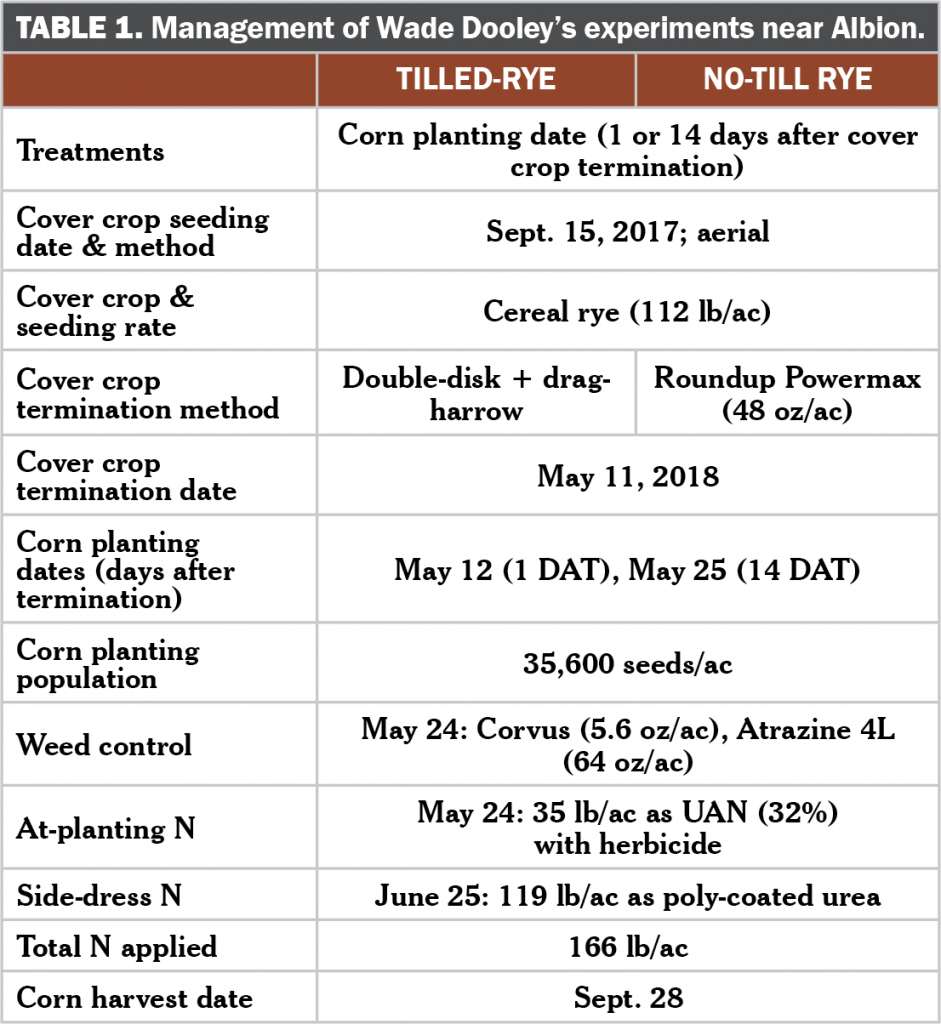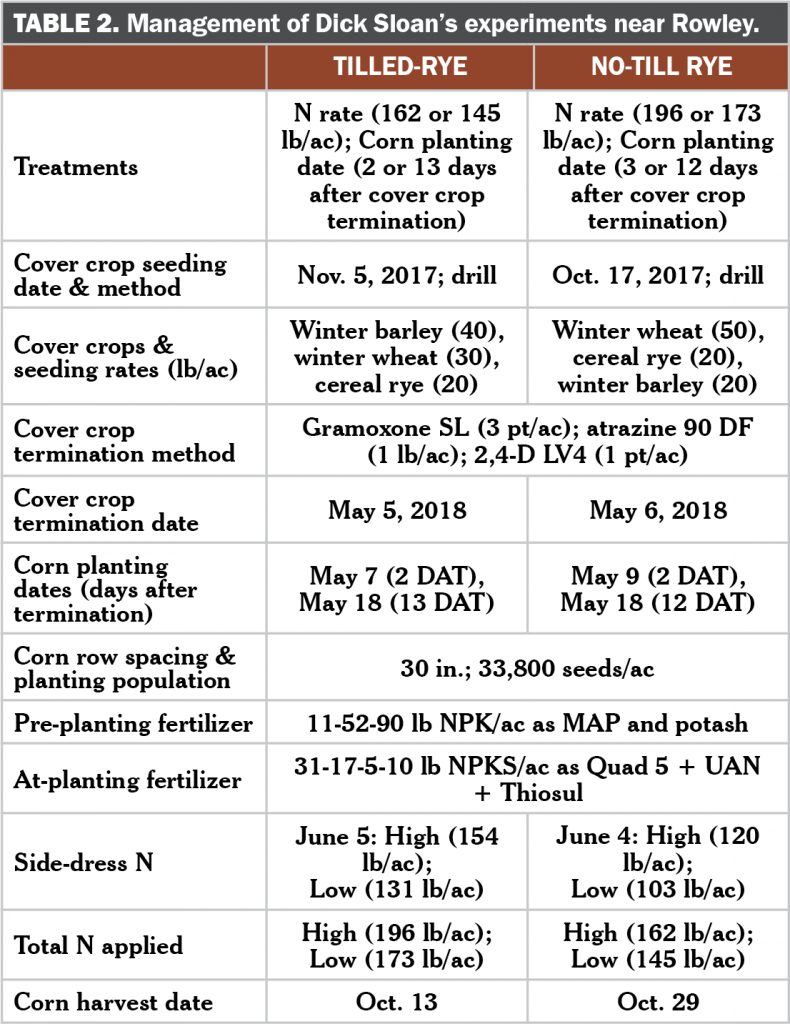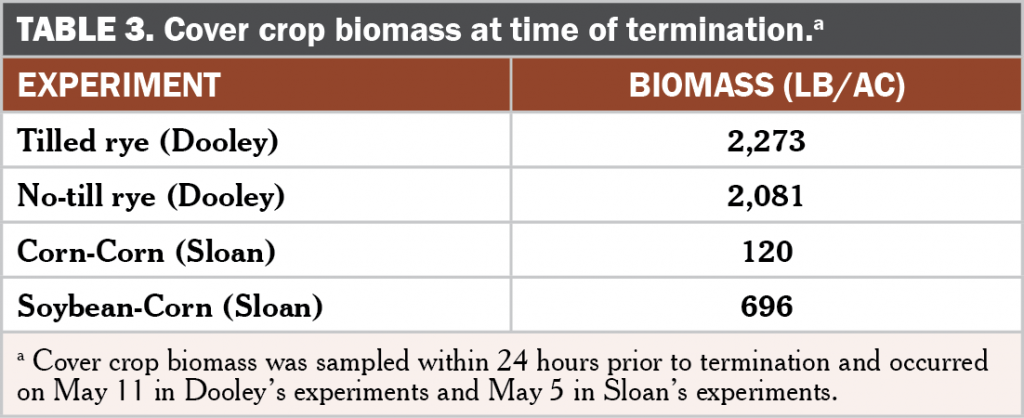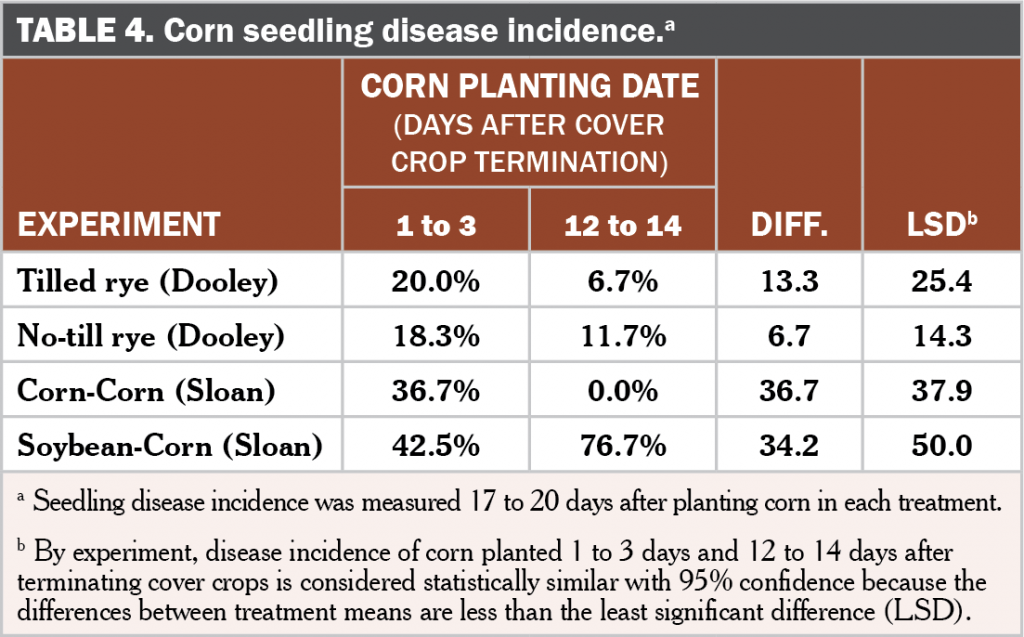Corn Planting Date Following Cover Crop Termination: Can Corn Be Planted Into a Freshly Terminated Cover Crop?
By Hayley Nelson and Stefan Gailans
This project was supported by the Iowa Department of Agriculture and Land Stewardship, Division of Soil Conservation and Water Quality, the Walton Family Foundation and AgSource Laboratories.
In a Nutshell:
- Yield drag and seedling diseases in corn planted fewer than 10 days after terminating cover crops can delay corn planting beyond the recommended dates for maximum yield.
- With the hypothesis that corn could be planted earlier into small amounts of biomass without sacrificing yield or increasing disease, Wade Dooley and Dick Sloan compared yields and disease incidence between corn planted 1 to 3 days and 12 to 14 days after terminating cover crops that accumulated no more than 3,000 lb/ac of biomass. Sloan additionally investigated the impact of varying nitrogen rates on corn yield and stalk rot incidence.
Key Findings
- Terminating a cover crop before it accumulated 3,000 lb/ac of biomass allowed Dooley and Sloan to plant corn as early as 1 day after cover crop termination (DAT) without sacrificing yield or increasing the incidence of seedling diseases. Incidence of stalk rot was greater in corn planted 1 DAT compared to corn planted 14 DAT in 1 of 3 experiments.
- While this and other studies show it is possible to plant corn earlier when terminating cover crops with smaller amounts of biomass, other studies have produced different results. Having clear goals in mind for a cover crop can inform management decisions, but be prepared for a different outcome than planned.
Background
Proper management for corn following a cover crop typically requires planting the corn ten to 14 days after terminating the cover crop. When this planting rule is followed, corn yield drag after a cereal rye cover crop can be avoided as demonstrated by nine years of research by farmers in Iowa.[1] Yield drag from cover crops is thought to result from early season soil and fertilizer nitrogen immobilization[2,3] and increased prevalence of disease pathogens.[4] The amount of cover crop biomass produced could be a contributing factor to yield drag. Corn populations in an Iowa experiment[5] and soil nitrate in a Michigan experiment[3] decreased with increasing amounts of cereal rye biomass.
PFI cooperator Dick Sloan became interested in investigating the role of cover crop biomass in corn yield drag after observing results from one of his 2017 trials. In that experiment, yields of corn planted two days after termination of a cover crop compared to yields of corn planted 21 days after termination were reduced when the cover crop accumulated more than 4,000 lb/ac of biomass but not when the cover crop accumulated less than 3,000 lb/ac of biomass.[6] Based on those findings, Sloan hypothesized, “It’s not the cover crop termination date. It’s the amount of biomass produced.” Because waiting to plant corn until ten to 14 days after terminating a cover crop can delay planting until later than what is considered ideal to maximize yield, narrowing the period between cover crop termination and corn planting is an interest among PFI cooperators.
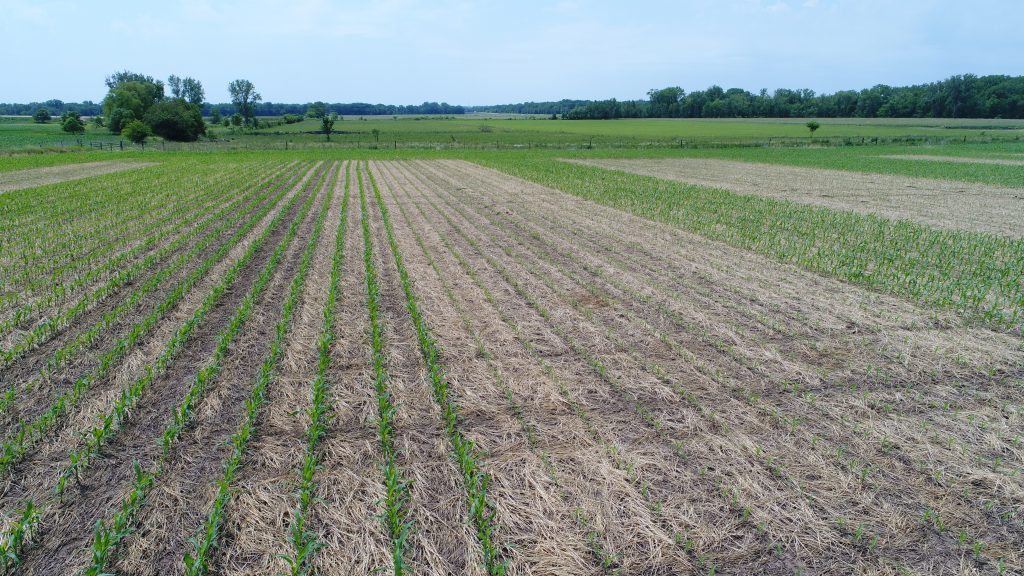
Corn planted 1 to 3 days after cover crop termination (left) and corn planted 12 to 14 days after cover crop termination (right) in Dooley’s no-till rye experiment. The cover crop was terminated the same date in both treatments – May 11, 2018. Photo taken June 8, 2018.
Objective: The objective of this research project was to determine if terminating a cover crop before accumulating 3,000 lb/ac of biomass would allow corn to be planted sooner than 10 days after termination (DAT) without sacrificing yield or increasing disease incidence.
PFI cooperators Wade Dooley and Dick Sloan kept an eye on their cereal rye cover crops in the spring and terminated them before they produced 3,000 lb/ac of biomass. “I need to know more about the interaction of a cereal rye cover crop and corn growth and production,” said Dooley about conducting the trial. Sloan was most curious about eliminating the delay between cover crop termination and corn planting. “I want to plant corn when my neighbors are planting so they will consider cover crops on their fields.”
Methods
This study was conducted by Wade Dooley near Albion in Marshall County and Dick Sloan near Rowley in Buchanan County. Dooley investigated the influence of corn planting date relative to cover crop termination (1 or 14 DAT) on corn yield as well as seedling disease incidence, stalk rot incidence and soil microbial activity by running the same experiment in two separate fields – one with a cereal rye cover crop terminated by tillage (tilled-rye) and the other with a cereal rye cover crop terminated by herbicide (no-till rye). Treatments in Dooley’s tilled-rye and no-till rye experiments were arranged in a randomized complete block design with six replications and treatment strips measured 15-ft wide by 330-ft long. Sloan investigated the influence of nitrogen application rates (high or low) as well as the influence of corn planting date relative to cover crop termination (2 DAT or 12 to 13 DAT) on seedling disease incidence, stalk rot incidence, soil microbial activity and yield. Sloan conducted the trial twice: once in a field that was previously planted to corn (corn-corn) and once in a field that was previously planted to soybean (soybean-corn). Treatment strips in Sloan’s experiments were the width of his combine and the length of his field and were arranged in a split-plot randomized complete block design with corn planting date in relation to cover crop termination as the whole plot factor and nitrogen rate as the split-plot factor. Treatments were replicated three times in Sloan’s corn-corn experiment and four times in his soybean-corn experiment.
Dooley and Sloan planted cover crops in Fall 2017 and terminated them in Spring 2018 before they accumulated 3,000 lb/ac of biomass. Detailed summaries of the management of experiments for both farms is provided in Table 1 and Table 2.
Field sampling
Cover crop biomass was sampled within 24 hours prior to termination in all experiments. Aboveground biomass was collected from 1-ft by 1-ft quadrats, air-dried for three weeks and weighed.

Sampling quadrat and materials used to collect biomass of Sloan’s cover crop (winter barley, winter wheat, cereal rye) in his corn-corn rotation. Photo taken at time of cover crop termination – May 5, 2018.
Incidence of corn seedling disease was assessed by Dr. Alison Robertson’s lab team (ISU Department of Plant Pathology and Microbiology). Assessments occurred 17 to 20 days after planting corn for each treatment and were done prior to establishing the split-plot treatment (nitrogen rate) in Sloan’s experiments. Fall stalk rot assessments were also conducted by Dr. Robertson’s lab team on Sept. 13 in both of Dooley’s experiments and in Sloan’s corn-corn experiment.
Soil samples were collected to a 6-in. depth in mid-June in all experiments. Samples were tested using the Solvita assay at AgSource Laboratories (Ellsworth, IA) to determine the burst of CO2-C following rewetting of dried samples.

Tilled-rye (left) and no-till rye (right) experiments at Wade Dooley’s showing replicated strips of both treatments – corn planted 1 to 3 or 12 to 14 days after termination of cereal rye. Photo taken June 8, 2018.
Corn was harvested individually from each strip on both farms and corrected to 15.5% moisture.
Data were analyzed using JMP Pro 13 (SAS Institute Inc., Cary NC) statistical software. Means separations are reported using Tukey’s Least Significant Difference (LSD). Statistical significance was determined at the 95% confidence level.
Results and Discussion
Cover crop biomass
The cover crop in all experiments was terminated prior to accumulating 3,000 lb/ac of biomass (Table 3). At Dooley’s, till-terminated rye accumulated 2,273 lb/ac of biomass by the time of termination (May 11) and herbicide-terminated rye accumulated 2,081 lb/ac of biomass before termination on May 11. At the time of termination at Sloan’s – May 5 (corn-corn) or May 6 (soybean-corn) – the corn-corn rotation produced 120 lb/ac of cover crop biomass and the soybean-corn rotation produced 696 lb/ac.
Corn seedling disease incidence
The results of these experiments indicate the incidence of disease in corn seedlings is not influenced by the duration between terminating cover crops and planting corn (Table 4). These results conflict with findings of Arlyn Kauffman’s 2018 on-farm trial as well as findings of a 2017 Iowa State University study – both of which found corn planted shortly before or after terminating a cereal rye cover crop had higher incidence of seedling diseases than corn planted 10 or more days after termination.[4,7]
Solvita soil CO2-C burst
For each experiment, Solvita assays revealed no significant differences in the amount of CO2-C respired over a 24-hour period between soil samples collected from corn-planting-date treatments (Table 5).
Incidence of stalk rot differed significantly between corn planted 1 versus 14 days after tilling rye in Dooley’s tilled-rye experiment (Figure 1). Incidence was 14% in corn planted 1 DAT and 0% in corn planted 14 DAT. Causes of the difference in stalk rot incidence between treatments in Dooley’s tilled-rye experiment are not clear as stalk rot pathogens are not yet well understood. There are many different stalk rot pathogens and each can be affected by countless environmental factors.[8] Average rainfall in May was well below normal but jumped to well above normal in June (Figure A1). It is possible soil moisture was ideal for infection of corn by stalk rot pathogens at the time of planting the early-planted corn (May 12) but less ideal at the time of the later corn planting date (May 25). There was no difference in incidence of stalk rot between treatments in Dooley’s no-till rye experiment.

FIGURE 1. Incidence of stalk rot in corn in Wade Dooley’s tilled-rye (A) and no-till rye (B) experiments as affected by the corn planting date in relation to termination of the cover crop, and incidence of stalk rot in corn in Dick Sloan’s corn-corn experiment (C) as affected by corn planting date in relation to termination of the cover crop or the level of nitrogen fertilizer. Values above columns are treatment means. By farm and treatment, when the difference between the treatment means is greater than the least significant difference (LSD), the means are followed by different letters and are considered statistically different at the 95% confidence level.
In Sloan’s corn-corn rotation, neither the gap between terminating a cover crop and planting corn nor the nitrogen fertilizer rate were found to influence incidence of stalk rot (Figure 1). Incidence of stalk rot in corn planted 2 DAT and 13 DAT was 9% and 8%, respectively, and incidence of stalk rot in plots with a high nitrogen rate (196 lb/ac) or a low nitrogen rate (173 lb/ac) was 10% and 8%, respectively. Incidence of stalk rot was not measured in Sloan’s soybean-corn rotation.
Crop yields
At Dooley’s, corn planted 1 DAT in both experiments resulted in greater yields than corn planted 14 DAT (Figure 2). Yield in the tilled-rye experiment for corn planted 1 and 14 days after tilling rye was 209 and 191 bu/ac, respectively. Yield in the no-till rye experiment for corn planted 1 and 14 days after termination of rye with herbicides was 207 and 192 bu/ac, respectively. Yields in both experiments at Dooley’s were below the 3-year average of 220 bu/ac for Marshall County.[9] Low rainfall in May may have contributed to this (Figure A1).
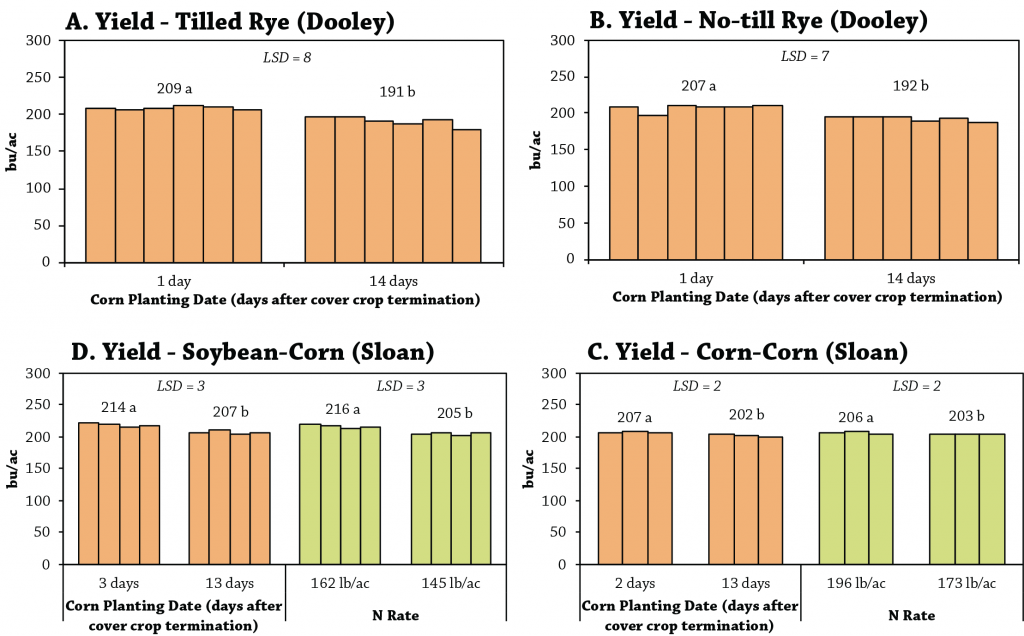
FIGURE 2. Corn yield in Dooley’s tilled-rye (A) and no-till rye (B) experiments as affected by the corn planting date in relation to termination of the cover crop, and corn yield in Sloan’s corn-corn (C) and soybean-corn (D) experiments as affected by the corn planting date in relation to termination of the cover crop or the level of nitrogen fertilizer. Columns represent individual strip yields. Values above clustered columns are the treatment means. By farm and treatment, yields are considered statistically different at the 95% confidence level when the difference between two means is greater than the least significant difference (LSD) and are followed by different letters.
At Sloan’s, both nitrogen rate and the corn planting date affected yields. Results of both experiments at Sloan’s followed the same pattern as Dooley’s. Planting corn 2 to 3 DAT resulted in greater corn yields (207 bu/ac corn-corn, 214 bu/ac soybean-corn) than planting 13 DAT (202 bu/ac corn-corn, 207 bu/ac soybean-corn) and the higher nitrogen rate in both rotations resulted in greater corn yields (206 bu/ac corn-corn, 216 bu/ac soybean-corn) than yields in the low nitrogen rate (203 bu/ac corn-corn, 205 bu/ac soybean-corn) (Figure 2). Yields in both experiments at Sloan’s were near the 3-year corn yield average for Buchanan County of 211 bu/ac.[9]
Our yield results run contrary to the prevailing understanding that planting of corn should be delayed by several weeks after termination of a cover crop to avoid yield drag.[2]
Conclusions and Next Steps
Terminating a fall cover crop before it accumulated 3,000 lb/ac of biomass allowed Sloan and Dooley to plant corn as early as 1 day after cover crop termination without increasing the incidence of seedling disease or decreasing yield. While these results may be encouraging for growers seeking to plant corn earlier after terminating a cover crop, a couple points should be considered before adopting the practices used in these trials. First, the dynamics of the relationship between cover crop biomass and corn yield are complex and not well understood. Evidence from other studies has produced inconsistent results – sometimes yields increase proportionally to decreases in cover crop biomass, but other times that is not the case.[10] The second thing to keep in mind is that while terminating a cover crop prior to accumulation of 3,000 lb/ac of biomass may sometimes eliminate yield drag in corn, it may also eliminate their benefits such as improved soil quality and weed control. These results highlight the idea that growers should have clear goals in mind for a cover crop before planting and manage it accordingly.
Appendix – Weather Conditions
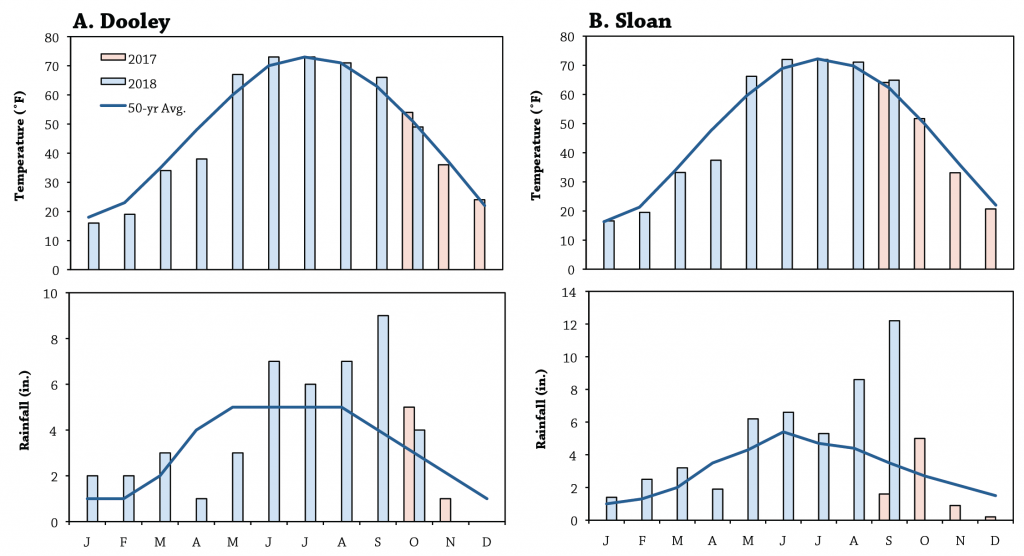
FIGURE A1. Mean monthly temperature and rainfall for Oct. 2017 through Oct. 2018 and the 50-year averages for A) the Marshalltown weather station (8 mi. from Dooley’s farm in Albion) and B) the Independence weather station (9 mi. from Sloan’s farm in Rowley).[11]
References
- Gailans, S., L. Juchems, B. Buman, R. Caviness, J. Funcke, D. Green, R. Juchems, R. Davis, D. Pierce, M. Pokorny, G. Schaefer, J. Sindt, R. Stout, G. Nelson, D. Nelson and K. Tobin. 2019. Winter Cereal Rye Cover Crop Effect on Cash Crop Yield, Year 10. Iowa Learning Farms, Practical Farmers of Iowa Cooperators’ Program. https://practicalfarmers.org/research/winter-cereal-rye-cover-crop-effect-of-cash-crop-yield-year-10/ (accessed March 2019).
- Vaughan, J.D. and G.K. Evanylo. 1998. Corn Response to Cover Crop Species, Spring Desiccation Time, and Residue Management. Agronomy Journal. 90:536–544. https://www.agronomy.org/publications/aj/abstracts/90/4/AJ0900040536 (accessed April 2019).
- Hill, E.C., K.A. Renner, C.L. Sprague and J.E. Fry. 2017. Structural Equation Modeling of Cover Crop Effects on Soil Nitrogen and Dry Bean. Agronomy Journal. 109:2781–2788. https://dl.sciencesocieties.org/publications/aj/abstracts/109/6/2781?access=0&view=pdf (accessed April 2019).
- Acharya, J., M.G. Bakker, T.B. Moorman, T.C. Kaspar, A.W. Lenssen and A.E. Robertson. 2017. Time Interval Between Cover Crop Termination and Planting Influences Corn Seedling Disease, Plant Growth, and Yield. Plant Disease. 101:591–600. https://apsjournals.apsnet.org/doi/pdf/10.1094/PDIS-07-16-0975-RE (accessed April 2019).
- Kaspar, T.C., M.G. Bakker, T.C. Kaspar and M.G. Bakker. 2015. Biomass Production Of 12 Winter Cereal Cover Crop Cultivars And Their Effect On Subsequent No-till Corn Yield. Journal of Soil and Water Conservation. 70:353–364. http://www.jswconline.org/content/70/6/353.short (accessed April 2019).
- Gailans, S., D. Sloan and T. Sieren. 2017. N Fertilizer Strategies for Corn Following Cover Crop. Practical Farmers of Iowa Cooperators’ Program. https://practicalfarmers.org/research/n-fertilizer-strategies-for-corn-following-cover-crop/ (accessed April 2019).
- Gailans, S. and A. Kauffman. 2018. Cereal Rye Cover Crop Termination Date Before Corn. Practical Farmers of Iowa Cooperators’ Program. https://practicalfarmers.org/research/cereal-rye-cover-crop-termination-date-before-corn/ (accessed May 2019).
- Dodd, J.L. 1980. The Role of Plant Stresses in Development of Corn Stalk Rots. Plant Disease. 64:533–537. https://www.apsnet.org/publications/plantdisease/backissues/Documents/1980Articles/PlantDisease64n06_533.PDF (accessed May 2019).
- Johanns, A. 2019. Historical Corn Yields by County in Iowa. A1-12. Ag Decision Maker. Iowa State University Extension and Outreach. https://www.extension.iastate.edu/AgDM/crops/pdf/a1-12.pdf (accessed May 2019).
- Martinez-Feria, R.A., R. Dietzel, M. Liebman, M.J. Helmers and S. V Archontoulis. 2016. Rye cover crop effects on maize: A system-level analysis. Field Crops Research. 196:145–159. https://www.sciencedirect.com/science/article/pii/S0378429016302027 (accessed May 2019).
- Iowa Environmental Mesonet. 2019. IEM “Climodat” Reports. Iowa State University Department of Agronomy. http://mesonet.agron.iastate.edu/climodat/ (accessed May 2019).


